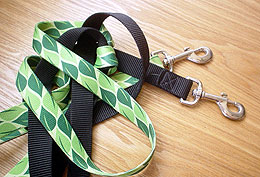Not a Leash-Lovin’ Dog: Teaching Puppies About the Joys of Walks
 Troy wrote: Our family has recently acquired an Australian Shepherd as our newest family member.
Troy wrote: Our family has recently acquired an Australian Shepherd as our newest family member.
The problem I have is, when I apply any resistance on the leash to get him to come or walk, he immediately begins to flop around violently like he is having a seizure.
Do I just let him flop until he learns ‘that's the way it's going to be’ or should I take another approach?
Kingdom of Pets replied:
First of all we need to rule out pain. Make sure his collar is not too tight or too loose. If you can put two fingers snugly between the collar and his neck the fit is good. If your puppy does not run around much or is also reluctant to move at times when not on the leash ask your vet to check your puppy over for illness or injury especially of the feet and legs.
Introducing Collars and Leads
Leash walking is very rewarding and exciting for most dogs, but your young puppy doesn't know this yet. Making the whole thing fun with play and treats will help get things moving in the right direction.
First of all bring the lead out regularly and have it lying around the house so your puppy gets used to the sight of it and doesn’t become anxious about it. Also put your puppy on the leash for 10 minutes at a time several times a day starting inside the house and later outside on the lawn or sidewalk. When you first start inside you don’t even need to be holding the leash just put it on gently while distracting your puppy with a fun game or treat and keep praising him while he remains unconcerned about it and is ignoring it. If your puppy goes to pick up or chew the lead give a gentle but firm ‘AHH’ and quickly distract him with a toy or treat then praise again. This will help prevent problems later on, such as leash chewing while walking.
Once your puppy is comfortable with the lead itself it’s time to start working on walking on the leash. Feeding time is a good time to work on this conditioning, when you have the dish in your hand and an eager puppy at your feet. With the leash attached, back away from the puppy. Use your body language and the puppy's name to attract the puppy to follow. Move around a bit with your puppy, making it a fun game, before putting down the dish and thus delivering a great reward.
At other times when your puppy is likely to be interested in games and treats, use a bit of food from the puppy's next meal to condition the puppy to look at you and move with you. Keep moving away from the puppy, encouraging the puppy to follow you. Young puppies naturally do this anyway, so the training is easy and fun. Pretty soon he will learn that being leashed is not a bad thing.
Once your dog is happy to walk on the leash and go for proper walks start reading up on teaching heel and good leash walking behavior from your Secrets to Dog Training manual to prevent bad pulling and walking behaviors from forming.
If you have an older rescue dog who is not used to leashes and collars you can use the method above to teach them too.
All the best,
![]()
Daniel Stevens and the Secrets to Dog Training Team
"Secrets to Dog Training - STOP Dog Behavior Problems!"
http://www.kingdomofpets.com/dogobediencetraining/
P.S. Forward this Newsletter to a friend
If you have a friend you think may be interested in training their dog or solving a particular dog behavior problem, please feel free to forward them this Newsletter.
P.P.S. Remember – you have full access to our Members’ Forum
Because you are a Member of ‘Secrets to Dog Training’ you have full access to our Members’ Forum. If you have a dog behavior question or a related problem, you are most welcome to bring it to the Forum. Post a detailed description for our trainers and fellow Members to read. Within 1-4 working days you will see recommendations on how to solve it once and for all.
If you haven’t already registered for the Forum, you can do this from the Members’ Area: http://www.kingdomofpets.com/dogobediencetraining/members/ or you can go straight there by clicking here – http://www.kingdomofpets.com/dog/forum/
Previous Newsletters
01 | 02 | 03 | 04 | 05 | 06 | 07 | 08 | 09 | 10 | 11 | 12 | 13 | 14 | 15
